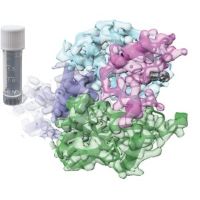Specification
| Description | Recombinant protein from the full-length sequence of Homo sapiens methyltransferase like 14 (METTL14) (NM_020961). |
| Organism | Homo sapiens (Human) |
| Expression Host | Human Cells |
| Tag Info | His or DYKDDDDK. Please contact us if you need further information or require specific designed tag. |
| Purity | Greater than 90% by SDS-PAGE gel |
| Uniprot ID | Q9HCE5 |
| Entry Name | MET14_HUMAN |
| Gene Names | METTL14 KIAA1627 |
| Alternative Gene Names | KIAA1627 |
| Alternative Protein Names | N6-adenosine-methyltransferase non-catalytic subunit (Methyltransferase-like protein 14) (hMETTL14) |
| Application | Antigens, Western, ELISA and other in vitro binding or in vivo functional assays, and protein-protein interaction studies; For research & development use only! |
| Buffer | Purified protein formulated in a sterile solution of PBS buffer, pH7.2, without any preservatives |
| Endotoxin | Endotoxin level is < 0.1 ng/µg of protein (<1EU /µg) |
| Length | 456 |
| Molecular Weight(Da) | 52150 |
| Protein Sequence | (The sequence of expressed protein may have some variation from the sequence shown below. Please contact us for the exact sequence.) MDSRLQEIRERQKLRRQLLAQQLGAESADSIGAVLNSKDEQREIAETRETCRASYDTSAPNAKRKYLDEGETDEDKMEEYKDELEMQQDEENLPYEEEIYKDSSTFLKGTQSLNPHNDYCQHFVDTGHRPQNFIRDVGLADRFEEYPKLRELIRLKDELIAKSNTPPMYLQADIEAFDIRELTPKFDVILLEPPLEEYYRETGITANEKCWTWDDIMKLEIDEIAAPRSFIFLWCGSGEGLDLGRVCLRKWGYRRCEDICWIKTNKNNPGKTKTLDPKAVFQRTKEHCLMGIKGTVKRSTDGDFIHANVDIDLIITEEPEIGNIEKPVEIFHIIEHFCLGRRRLHLFGRDSTIRPGWLTVGPTLTNSNYNAETYASYFSAPNSYLTGCTEEIERLRPKSPPPKSKSDRGGGAPRGGGRGGTSAGRGRERNRSNFRGERGGFRGGRGGAHRGGFPPR |
Background
| Function | FUNCTION: The METTL3-METTL14 heterodimer forms a N6-methyltransferase complex that methylates adenosine residues at the N(6) position of some mRNAs and regulates the circadian clock, differentiation of embryonic stem cells and cortical neurogenesis (PubMed:24316715, PubMed:24407421, PubMed:25719671, PubMed:29348140, PubMed:27373337, PubMed:27281194). In the heterodimer formed with METTL3, METTL14 constitutes the RNA-binding scaffold that recognizes the substrate rather than the catalytic core (PubMed:27627798, PubMed:27373337, PubMed:27281194, PubMed:29348140). N6-methyladenosine (m6A), which takes place at the 5'-[AG]GAC-3' consensus sites of some mRNAs, plays a role in mRNA stability and processing (PubMed:24316715, PubMed:24407421, PubMed:25719671). M6A acts as a key regulator of mRNA stability by promoting mRNA destabilization and degradation (By similarity). In embryonic stem cells (ESCs), m6A methylation of mRNAs encoding key naive pluripotency-promoting transcripts results in transcript destabilization (By similarity). M6A regulates spermatogonial differentiation and meiosis and is essential for male fertility and spermatogenesis (By similarity). M6A also regulates cortical neurogenesis: m6A methylation of transcripts related to transcription factors, neural stem cells, the cell cycle and neuronal differentiation during brain development promotes their destabilization and decay, promoting differentiation of radial glial cells (By similarity). {ECO:0000250|UniProtKB:Q3UIK4, ECO:0000269|PubMed:24316715, ECO:0000269|PubMed:24407421, ECO:0000269|PubMed:25719671, ECO:0000269|PubMed:27281194, ECO:0000269|PubMed:27373337, ECO:0000269|PubMed:27627798, ECO:0000269|PubMed:29348140}. |
| Pathway | |
| Protein Families | MT-A70-like family |
| Tissue Specificity |
QC Data
| Note | Please contact us for QC Data |
| Product Image (Reference Only) |  |

